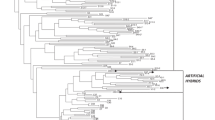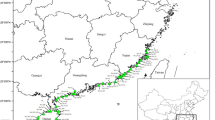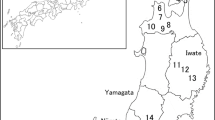Abstract
Dwarf bamboo species are monocarpic. They flower simultaneously and die after several decades. The type of flowering in the genus Sasa ranges from sporadic to gregarious. In order to determine whether or not the sporadic flowering of dwarf bamboo is fixed genetically, we investigated the distribution of clones using eight microsatellite (SSR) loci in a sporadic flowering patch of Sasa cernua Makino, a major dwarf bamboo species found in central Hokkaido. In May 2006, flowering occurred on 60.5% of living culms in a 1600 m2 patch. We established a 50 × 10 m study plot in this patch and noted 1267 clumps consisting of 2529 living culms. We investigated all 1267 clumps and identified six multilocus genotypes as clones using five variable SSR loci. All flowering clumps belonged to the same clone. On the other hand, non-flowering vegetative clumps were also discovered to be of the same clone. These data suggest that all flowering culms originated from a single clone of a sporadic flowering patch of S. cernua. Clonal analysis for investigation of sporadic flowering of S. cernua revealed that only a portion of a clone flowers and dies instead of the whole clone.



Similar content being viewed by others
References
Campbell JJN (1985) Bamboo flowering patterns: a global view with special reference to East Asia. J Am Bamboo Soc 6:17–35
Isagi Y, Shimada K, Kushima H, Tanaka N, Nagao A, Ishikawa T, Onodera H, Watanabe S (2004) Clonal structure and flowering traits of a bamboo [Phyllostachys pubescens (Mazel) Ohwi] stand grown from a simultaneous flowering as revealed by AFLP analysis. Mol Ecol 13:2017–2021
Kitamura K, Kawahara T (2007) Flowering culm dynamics in sporadic flowering of Sasa cernua Makino. Bull FFPRI 6:239–244
Kudoh H, Kadomatsu M, Noda M (1994) Sporadic flowering and regeneration of Sasa kurilensis Makino et Shibata (I). Bamboo J 12:56–63 (in Japanese with English summary)
Makita A (1992) Survivorship of a monocarpic bamboo grass, Sasa kurilensis, during the early regeneration process after mass flowering. Ecol Res 7:245–254
Makita A (1997) Rhizome habits of Sasa kurilensis. Bamboo J 14:20–27 (in Japanese with English summary)
Makita A, Konno Y, Fujita N, Takada K, Hamahata E, Mihara T (1988) Mass flowering of Sasa tsuboiana in Hira Mountains. Bamboo J 6:14–21 (in Japanese with English summary)
Makita A, Abe M, Miguchi H, Nakashizuka T (2004) Population dynamics of Sasa kurilensis for 8 years after mass flowering to the south of Lake Towada, with special reference to the non-flowered populations. Bamboo J 21:57–65 (in Japanese with English summary)
Matsuo A, Suyama Y, Sangetsu Y, Huzi S, Makita A (2008) Identified large genet of Sasa kurilensis by the DNA analysis. Bamboo J 25:64–73 (in Japanese with English summary)
McLellan AJ, Prati D, Kaltz O, Schmid B (1997) Structure and analysis of phenotypic and genetic variation in clonal plants. In: de Kroon H, van Groenendael J (eds) The ecology and evolution of clonal plants. Backhuys Publishers, Leiden, The Netherlands, pp 185–210
Nagamitsu T, Ogawa M, Ishida K, Tanouchi H (2004) Clonal diversity, genetic structure and mode of recruitment in a Prunus ssiori population established after volcanic eruptions. Plant Ecol 174:1–10
Nagao A, Ishikawa T (1998) Simultaneous flowering of Phyllostachys pubescens grown from seeds at Forestry and Forest Products Research Institute. Forest Pests 47:11–14 (in Japanese)
Numata M (1970) Conservational implications of bamboo flowering and death in Japan. Biol Conserv 2:227–229
O’Connell LM, Ritland K (2004) Somatic mutations at microsatellite loci in western red cedar (Thuja plicata: Cupressaceae). J Hered 95:172–176
Saito H, Fujimori H, Kitamura K (2000) Studies on isozyme variations and the retrogressive style in Tanzawa populations of Suzutake (Sasa borealis). Bull Kanagawa Prefecture Forest Res Inst 27:1–14 (in Japanese)
Saitoh T, Seiwa K (2007) Physiological integration of clonal plants: resource acquiring strategies in clonal fragments of a dwarf bamboo, Sasa palmate. Jpn J Ecol 57:229–237 (in Japanese)
Saitoh T, Seiwa K, Nishiwaki A (2002) Importance of physiological integration of dwarf bamboo to persistence in forest understorey: a field experiment. J Ecol 90:78–85
Saitoh T, Seiwa K, Nishiwaki A (2006) Effects of resource heterogeneity on nitrogen translocation within clonal fragments of Sasa palmata: an isotopic (15N) assessment. Ann Bot 98:657–663
Schmid B, Harper JL (1985) Clonal growth in grassland perennials. I. Density and pattern dependent competition between plants with different growth forms. J Ecol 73:793–808
Simmonds NW (1980) Monocarpy, calendars and flowering cycles in Angiosperms. Kew Bull 35:235–245
Suyama Y, Obayashi K, Hayashi I (2000) Clonal structure in a dwarf bamboo (Sasa senanensis) population inferred from amplified fragment length polymorphism (AFLP) fingerprints. Mol Ecol 9:901–906
Vange V (2002) Breeding system and inbreeding depression in the clonal plant species Knautia arvensis (Dipsacaceae): implications for survival in abandoned grassland. Biol Conserv 108:59–67
Watanabe M, Ueda K, Manabe I, Akai T (1982) Flowering, seeding, germination and flowering periodicity of Phyllostachys pubescens. J Jpn Forest Soc 64:107–111
Yamazaki K, Nakagoshi N (2005) Regeneration of Sasa kurilensis and tree invasion after sporadic flowering. Bamboo J 22:93–103
Acknowledgments
We thank Yoshihisa Suyama and Teruyoshi Nagamitsu for their technical advice and discussions, and Wajiro Suzuki for critical reading of the manuscript. We are also grateful to Makoto Kobayashi, Yukiko Sakamoto, and Akiko Yonezawa for their assistance in field and laboratory. This study was supported by Grants-in-Aid for Scientific Research (18580153, 20580167) from the Japan Society for the Promotion of Science.
Author information
Authors and Affiliations
Corresponding author
Rights and permissions
About this article
Cite this article
Kitamura, K., Kawahara, T. Clonal identification by microsatellite loci in sporadic flowering of a dwarf bamboo species, Sasa cernua . J Plant Res 122, 299–304 (2009). https://doi.org/10.1007/s10265-009-0220-1
Received:
Accepted:
Published:
Issue Date:
DOI: https://doi.org/10.1007/s10265-009-0220-1




